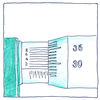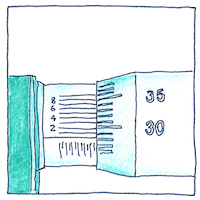William Gascoigne
metrology
astronomy

|
Micrometer
William Gascoigne discovered a spider’s web at the focal point of a telescope he was designing and realized that if he added crosshairs at that point it would be easier to locate the center of the field of view. He thus made the first telescopic sight. Then Gascoigne realized that by placing two parallel hairs and adjusting their separation using a fine screw he could measure the size of the image in his view and therefore calculate the relative size of objects in the sky. He thus made the first micrometer.
Measuring comets
Richard Towneley improved Gascoigne’s telescopic micrometer and Robert Hooke used it to measure the sizes of comets. Henry Maudslay invented the industrially practical screw-cutting lathe and the first bench micrometer in about 1805, accurate to one ten-thousandth of an inch. Jean Laurent Palmer became so well known for his handheld micrometer-screw calipers that the device is called a palmer in French and the Palmer screw in Spanish and inspired similar devices around the world.
Measuring
If you can’t predict it maybe you can measure it. Maybe the measurement can be shared, a length of cord or a number of known lengths. Maybe the measurement will stand in the next century, although few things are truly constant.



Researchers at the University of Virginia report that the Greenwich prime meridian, once bisecting the Airy Transit Circle at the Royal Observatory in Greenwich, is now 102 meters to the east, the original line having been deflected because the local direction of gravitation affected the determination of the vertical.
See also in The book of science:
Readings in wikipedia: